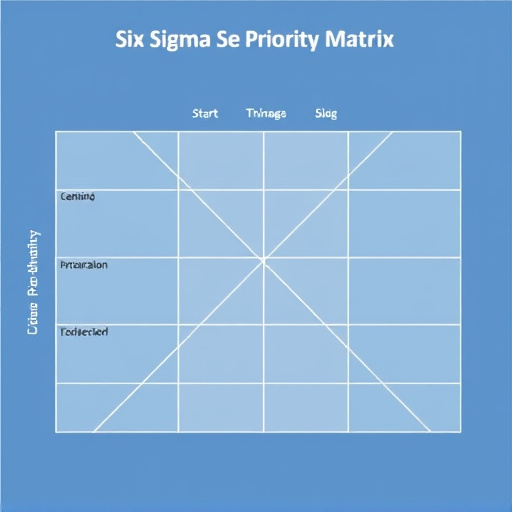The Six Sigma Action Priority Matrix is a strategic tool that helps organizations prioritize projects by evaluating their impact and urgency. This matrix divides tasks into four quadrants, enabling efficient decision-making and resource allocation. High-impact, urgent tasks are addressed immediately, while less urgent but important tasks are planned for later. By using this matrix, businesses can streamline processes, focus on high-value activities, and achieve tangible improvements, as demonstrated by successful real-world applications across various industries.
“Unleash the power of focused problem-solving with the Six Sigma Action Priority Matrix—a game-changer for process improvement. This matrix is a strategic tool that helps identify and prioritize action items, ensuring every effort aligns with project goals. In this comprehensive guide, we’ll explore its key components, benefits, and practical implementation steps. From understanding the matrix’s role in Six Sigma methodologies to real-world success stories, get ready to navigate complex projects with precision and efficiency.”
- Understanding the Six Sigma Action Priority Matrix
- Components and Benefits of Using the Matrix
- How to Implement the Matrix in Your Project
- Real-World Applications and Success Stories
Understanding the Six Sigma Action Priority Matrix

The Six Sigma Action Priority Matrix is a powerful tool that helps organizations prioritize actions and projects based on their impact and urgency, two critical factors in successful Six Sigma initiatives. This matrix categorizes tasks into four quadrants: Important and Urgent, Important but Not Urgent, Urgent but Not Important, and Not Urgent or Important. Tasks that fall under the “Important and Urgent” quadrant should be addressed immediately as they have a significant impact on business objectives and require swift action.
In contrast, the “Urgent but Not Important” category represents tasks that while time-sensitive, may not align with long-term strategic goals. Effectively managing these tasks is crucial to prevent getting caught up in short-term pressures at the expense of sustained growth. Understanding and applying the Six Sigma Action Priority Matrix enables teams to focus on high-value activities, streamlining processes, and driving measurable improvements across the organization.
Components and Benefits of Using the Matrix

The Six Sigma Action Priority Matrix is a powerful tool that helps organizations prioritize actions and projects based on their impact and urgency, ensuring efficient allocation of resources. This matrix consists of two main components: the impact axis and the urgency axis. Actions are plotted on this matrix, with high-impact tasks placed in the top-right quadrant (for immediate attention) and low-impact tasks in the bottom-left (for later consideration).
By using this matrix, organizations reap numerous benefits. It enables a structured approach to decision-making by providing a clear view of which projects require urgent attention and which can wait. This facilitates focused problem-solving, allowing teams to allocate their efforts where they will have the most significant impact. Additionally, it promotes efficient resource management, ensuring that high-value initiatives receive adequate support while less critical tasks are not overlooked but addressed in due time.
How to Implement the Matrix in Your Project

Implementing the Six Sigma Action Priority Matrix in your project is a strategic step that involves careful consideration and organization. Firstly, identify all the actions required to achieve your project goals. Then, plot each action on the matrix based on its urgency and importance. Actions with high urgency and high importance should be addressed first; these are typically the ‘Must Do’s’. Those that are urgent but less critical can be categorized as ‘Should Do’s’, while actions that are important but not urgent should go in the ‘Could Do’ section. This clear categorization allows project teams to prioritize effectively, ensuring resources are allocated to tasks that have the most significant impact on success.
Once the matrix is set up, it serves as a dynamic tool for ongoing decision-making. As your project progresses, regularly review and update the actions based on new information and changing circumstances. This real-time adjustment ensures your team stays focused on the most pressing matters, fostering a culture of continuous improvement.
Real-World Applications and Success Stories

The Six Sigma Action Priority Matrix has proven to be a powerful tool in various industries, enabling organizations to streamline their processes and achieve significant improvements. Its real-world applications are vast, from manufacturing and healthcare to finance and technology. For instance, a leading automotive manufacturer used this matrix to identify and prioritize projects aimed at reducing production defects, resulting in a 20% decrease in overall defect rates within a year.
In the healthcare sector, a hospital implemented the Six Sigma Action Priority Matrix to address patient wait times. By categorizing initiatives based on their impact and feasibility, they successfully reduced waiting times for non-emergency surgeries by 35%. These success stories highlight how the matrix facilitates focused efforts, ensuring resources are allocated efficiently. Organizations can leverage this tool to drive operational excellence and deliver tangible results in diverse business scenarios.
The Six Sigma Action Priority Matrix is a powerful tool that revolutionizes project management, especially within the framework of Six Sigma methodologies. By understanding and implementing this matrix, organizations can effectively prioritize actions, allocate resources efficiently, and drive successful outcomes. Its versatility allows for strategic decision-making, ensuring projects stay on track and deliver tangible results. This conclusion highlights the practical applications and benefits of adopting the Action Priority Matrix, making it an indispensable asset in any Six Sigma project’s arsenal.
